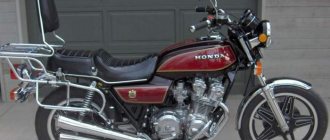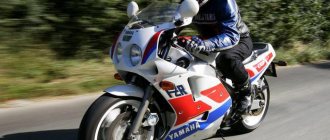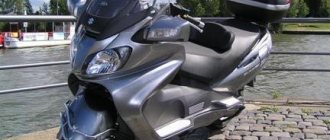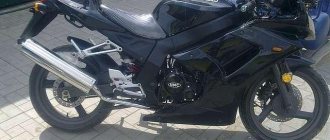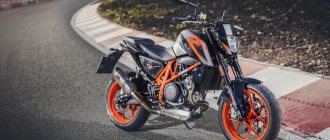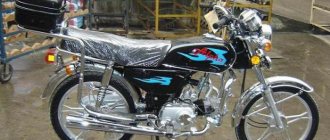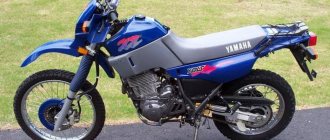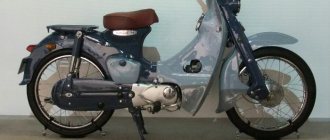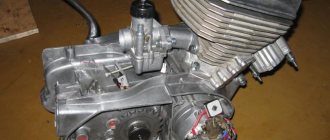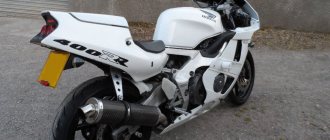The Suzuki Djebel 250 motorcycle was created in the fall of 1992. Its predecessor is considered to be the Suzuki DR, from which the new model inherited the same engine with cooling through air-oil circulation and an inverted front fork, also used on the DR-250S. In addition to the existing attributes, a large headlight with a protective clip was added. The fuel tank remained unchanged. The bike was produced until 1994. A review of the Suzuki Djebel 200 motorcycle is presented below.
Start of production
The bike debuted in mid-1993, after its successor, the SX-2000R, was discontinued. The motorcycle became popular almost immediately and, given the high demand, was produced intermittently until 2005.
At first, the Suzuki Djebel 200 enduro model was sold only on the domestic Japanese market, then small quantities were sent to Europe, where, after a short testing, the motorcycle began to be sold quite actively. Low cost and quality had an impact.
In addition, the 200 was designed for dual use - for rural areas and for urban highways. It should be noted that the motorcycle coped with both tasks with honor. The model is reliable, easy to operate and relatively inexpensive to maintain.
Review of the Suzuki Djebel 200 (DR 200 SE) motorcycle
I actively use it in the Crimean mountains and on the roads. Great motorcycle for the money. I bought it for 1850 green. I immediately changed the chain, sprockets, oil, both filters and wheel bearings. Everything else is in excellent condition. So far, even in Crimea, I haven’t found that hill that he doesn’t pull me into. Just right for small trips. Taking into account its consumption of 3.5 liters. Regarding the range on it. I bought it in Kyiv and drove it to Simferopol myself. I left at 6 am and was at home at 4 pm. 850 km approximately. I kept an average speed of 95 km (I tried 100). I drove in the mode - refueling - full tank - 5 minutes of coffee, refueling - full tank - 5 minutes of coffee, refueling - full tank - 5 minutes of coffee, refueling - full tank - 5 minutes of coffee. I didn't rest for more than 15 minutes. Normal even with my weight of 125 kg. But I’ve been accustomed to long-distance riders since the YAMAHA YBR-125 .
The mot is absolutely cool!!! I went for a season (364 days)))) I was just happy!!! despite the fact that I got the motorcycle at an expensive price and with a defect!!! and then I completely screwed it up (due to inexperience) Now I’m taking a TTR Reid and still restoring the dowels, for my wife! (but it seems to me that I will ride it more often than she))) The bike is cool but unique!!!
If you chose the right motorcycle, it is a very good one. The season is over. On the one hand, I want to replace it and try others, but I can’t find something else that suits my needs. For me Jebel 200 was the best.
pros:
- - Light, with a very low first and good lows. On standard chainrings it goes slowly, where others either need to rush or burn the clutch.
- — Low, on the slopes this is a big plus.
- — The saddle is not very narrow if you ride alone.
- — The tank is spacious, the range at one fill-up is large.
- - Narrow, in the city, in traffic jams, where everyone stands.
- — Headlight excellent, trunk.
- — In winter there are rear brakes.
- - Simple and reliable. If not killed.
Minuses:
- - Lightweight, blows away on the highway. It’s scary to leave it in the yard; 2 people can easily pick it up and carry it away.
- — It seems that the front fork is weak, maybe there is not enough power.
- — You can drive on the highway, but not very well. Nice. After 80 the dynamics are sluggish and slow.
- — Engine life is less than 250
The purpose of this motorcycle is for medium-distance travel. This is a very light touring bike. It turns out that he has no competitors. It seems you can take Jebel 250 , it’s ideal for travel, but the weight increase and the price are 80% more expensive than Jebel 200 .
Many take two hundred, as well as 250 Jebel for riding around the surrounding area. That's why they sell it afterwards. You can ride them around the surrounding area, but they are more for “tramps.” It’s not for nothing that the tanks have the inscription “for tourism.”
They brought me a Suzuki DJEBEL 200 (he gave me the name) 2 weeks ago from Japan. I live in a small town in the Moscow region. 50 km from Moscow Ring Road. forest nearby. fields nearby. this is a good mot. '98 but I'll give 2005-7. Everything is OK. On the highway it’s hard with the brakes and you have to make calculations for overtaking in advance. but if you work only with speeds, then the problem disappears. He's running around the field like that! that you wonder where the aisle and the fall are. ))))) I paid 150,000 and I’m happy as hell. this is not a spendthrift. this is a car.
Go to motorcycle Suzuki Djebel 200 (DR 200 SE)
Check out the test drives:
- Suzuki Djebel 200 or Yamaha Serow 225
Service as it is
The popularity of the car was facilitated by the wide technical service network that it deployed throughout Europe. Thus, there was no question of spare parts; any parts could be obtained within an hour, and repairs and replacements did not pose any problem, since qualified specialists were ready to work everywhere. Among other things, the motorcycle was structurally simple, without any frills. The owners could easily carry out many of the actions associated with minor repairs on their own without much difficulty if they had the simplest tool, a hammer, a set of keys and other devices at hand.
Suzuki Djebel 200 was modified in 1997. The landing was made lower, but the ground clearance remained the same. The coloring was varied. Camouflage in several combinations, silver tank with black trim. Mudguards on both wings, oil radiator for more efficient engine cooling. Export name - "Troyan-200". Some skeptics doubted the word “Trojan”, because everyone knows the story of the Trojan horse. Is there some kind of catch here too, buyers asked each other. However, the very first kilometers behind the wheel of a comfortable, dynamic motorcycle dispelled all doubts.
Hello. Feeling a steady craving for freedom of movement throughout life, I search for the way to it by touch.
For several years now, the motorcycle has been a part of my life. In a big city, I chose two wheels, first of all, to be able to feel like a human being for at least half a year, and not a happy element of a dynamically developing urban system. Of course, the bike is also about emotions from the process. But, squeezed by the rules and common sense in heavy traffic, I rather enjoy the time saved on the road.
The tenacity with which effective city managers are changing my city is worthy of praise. Increasingly, you are wondering whether to spend your free time away from bus lanes, paid parking lots, courtyards clogged with cars, and from the city in general. Having renounced cars, Moscow began to quarrel with motorcycles, narrowing the lanes and hanging cameras in the tail. Motorcycle travel has become a new outlet in search of freedom.
Russia lives freer outside the Moscow Ring Road. The wealth of choice of interesting places to travel makes your head spin. Federal highways will lead you to almost any regional center, where tourists will be sold a Chinese magnet and a Big Mac. You need to turn aside to the real beauties. The result of the work of not so effective regional leaders is not worthy of praise, but strangely the result is close to the capital. The amount of infrastructure available per person is slightly more than zero. There are no traffic jams, but there are no roads either. The limited freedom of movement on a road motorcycle in our country is becoming obvious. Here they are, they are beautiful, close by, but try to drive up. For the first time I’m thinking about more suitable transport.
Here it turns out that, on the instructions of far-sighted marketers, smart engineers have already thought of everything. An excellent choice for an adventure-seeking urban romantic should be an uncompromising crossover that has everything: comfort, power, 21 wheels and huge trunks. The complete lack of charisma was embarrassing, but in the forests there was no one to impress.
While studying the topic on YouTube, I came across a strange pattern - videos with touring enduros differ little from videos with RTs and GoldWings. It’s a bit boring, with the exception of the funny falls of equipped riders of monumental geese in ruts from SUVs and the heroic attempts to rescue formidable adventurers from harmless puddles 10 meters from the highway. The subsequent trip on the 900th Tiger confirmed the guess. Only pro-riders from advertising can conquer directions on a high 200+ kg motorcycle, but in real life, a tourenduro seems to be an excellent accessory to Timberlands and will add little to freedom of movement.
It was much more interesting to watch how the “light endurists” fervently rush along any trails and carelessly throw their XRs, KLXs and other TTRs down the hill. An off-road “check” with numbers is what I need.
I started searching. I was not happy that I was not yet ready to give up my “street” in favor of a single small-capacity model for all occasions. This means I’ll buy a second bike, and this is an extra investment. Therefore, we set a modest budget. I liked the new, inexpensive Chinese, but decided to play it safe and paid extra for an elderly Japanese. Yes, he was 12 years old, but he looked like he was 30, but for some reason he inspired a feeling of confidence, like an experienced grandfather on a mushroom trip.
I bought the Suzuki Djebel 200 without hesitation when I saw it in person. Round headlight, mirrors, tidy and turn signals, front fender with a hook, rear fender with a shovel, in short, the complete feeling of a solid thing, tested by time. This one definitely won’t whine on any country road. I was a little confused about how to drive it around “civilization”?
It turned out that in the city this little hunchback was jumping like a hare. It starts vigorously, changes lanes and goes where not every bike can. In traffic jams it will run away from any Hayabusa. The main thing is not to be afraid - there are no brakes on it. The front disc is decorative, the rear drum has two positions on and off.
On the highway the mood is different. We keep 80, follow the trucks, observe the scenery. If you live far from big roads or a radically Nordic warehouse, then you can even get high. Soft ride, wide saddle, endless tank (I used to ride 480 km on it) and a feeling of every mechanism working. It can be cranked up to 120, but the groan of the engine at high speeds is absolutely unbearable. In general, long-range shooting is possible, but it is contraindicated for the nervous system of a busybody like me.
Therefore, I moved him to the dacha closer to the places of future hikes. Instead of expanding my movement halo, I simply supplemented it.
And off we go. I took every opportunity to ride because I loved it. He fell, rose and fell again. The motorcycle easily endured abuses unimaginable for road vehicles. Some kind of childish delight - I can go wherever I want. Bumps, clearings, fords, clay, primers. A constant feeling of fighting with technology and nature. Complete immersion in the process, something I haven’t experienced for a long time while riding on flat roads.
The device, as expected, turned out to be well thought out and adapted. The engine has no tops, but it pulls like a tractor. The saddle, which is low even for my 172 cm, allows me to substitute my leg at any time. Very soft suspension allows me to rush across fresh arable land while sitting, and the brakes are now sufficient.
At some point I felt that I had reached a decent level of skating. All the surrounding areas had been explored by this point, and I didn’t really want to travel far on the jab. Interest in such enduro began to fade. I began to notice shortcomings: difficulty starting after inactivity and at low temperatures, sluggish throttle response, geometry not intended for stand-up driving, disgusting exhaust sound. And then my enduro accomplice offers to go to the competition. There is, he says, a “hobby” class, let’s show what we can do. My excitement and thirst for adventure awoke again.
We loaded the bikes into a pickup truck and drove off merrily. I don’t want to describe what happened next in detail. In short, I realized that I can do absolutely nothing. I am not able to pass any more or less endurous obstacle. All I could do was leave the race on time and maintain my technique. Well, it’s also a lot of fun for the rest of the participants. This motorcycle probably didn’t experience so much attention even when it was first shown to the public in 1993. Owners of KTMs, WRs and even Avantis twisted their fingers at their temples, patted them on the shoulder and advised them to go home.
I guessed that Djebel 200 is clearly not for logs, rocks and cliffs. But the fact that I am a complete zero, as an endurist, came as a surprise to me. New boundaries of freedom of movement appeared within me.
Two weeks ago, Jeb easily sold himself to a man who would ride him to pick mushrooms. And yesterday I bought myself a “new Chinese KTM” without a title or obligations to the state. 7 years after my first lessons, I again wanted to learn how to ride a motorcycle. The ability to move not only along any road, but in any direction seems to be a new goal.
"Pasaremos!"
Does color matter?
At first, the motorcycle was in demand mainly among the rural population, then they began to paint it in brighter colors and the situation leveled off; the Jebel 200 was now also purchased by urban residents. Of course, each buyer had his own stereotypical approach, some liked the orange camouflage, while others preferred more modest colors. However, everyone agreed on one thing - both villagers and city dwellers would like to purchase a reliable, trouble-free motorcycle, and what color, this can be discussed later.
The bike was produced for some time as the Jebel 250, but soon production completely switched to the Jebel 200, since the fuel savings were significant. And this option turned out to be the most successful, the production of the “200th” continued for quite a long time, and not only for reasons of low gasoline consumption - there were also a number of arguments in favor of the “200th”, one of which was the reliability of the design.
The motorcycle was not intended for racing either around the circuit or over rough terrain. It was a simple machine for easy operation under normal conditions. However, it turned out to be difficult to resist rushing along a good highway, especially for a young motorcyclist. The speed of the Jebel 200 was decent and was about 180 km per hour. Some owners even organized mini-competitions among themselves, just to test the technical capabilities of the car. And the motorcycle never let me down.
Technical characteristics of the Suzuki Djebel 250 motorcycle
Weight and dimensional parameters:
- bike length - 2150 mm;
- height - 1150 mm;
- width - 820 mm;
- height along the saddle line - 810 mm;
- wheelbase - 1412 mm;
- gas tank capacity - 13 liters;
- dry weight of the motorcycle - 108 kg;
- Fuel consumption is 3.6 liters per 100 km.
Dynamic indicators:
- maximum power - 24 hp. With.
Specifications
Technical characteristics of Suzuki Djebel 200:
| Model | Suzuki Djebel 200 – Japanese version Suzuki DR200SE – export version |
| Motorcycle type | enduro |
| Year of issue | 1993-2005 – Djebel 200 1995-2013 – DR200SE |
| engine's type | 1-cylinder, 4-stroke |
| Working volume | 199 cm³ |
| Cooling | air |
| Bore/Stroke | 66 x 58.2 mm |
| Compression ratio | 9,4:1 |
| Number of valves per cylinder | OHC, 2 valves |
| Fuel supply system | carburetor, 1x Mikuni BST31 |
| Ignition type | fully transistorized |
| Maximum power | 20 hp at 8500 rpm |
| Maximum torque | 17.65 Nm at 7000 rpm |
| Clutch | Multi-disc in oil bath, cable drive |
| Transmission | 5-speed |
| type of drive | chain |
| Frame | steel |
| Front suspension | telescopic fork, stroke – 205 mm |
| Rear suspension | Pendulum with monoshock absorber (preload adjustment), stroke – 205 mm |
| Front tire size | 70/100-21M/C 44P |
| Rear tire size | 100/90-18M/C 56P |
| Front brakes | 1 disc, 230 mm, 1-piston caliper |
| Rear brakes | drum, 130 mm |
| Motorcycle length | 2150 mm |
| Motorcycle width | 805 mm |
| Motorcycle height | 1150 mm |
| Seat height | 810 mm |
| Wheelbase | 1405 mm |
| Minimum ground clearance (clearance) | 260 mm |
| Gas tank capacity | 13 L 12.5 L – DR200SE (California) |
| Motorcycle weight (dry) | 108 kg – Djebel 200 113 kg – DR200SE |
| Motorcycle weight (curb) | 121 kg – Djebel 200 126 kg – DR200SE |
Model "Suzuki Jebel 200"
Getting to know the Suzuki DF200E should start with the engine. The DR200SE brand motor is worth studying in detail. He proved himself to be the best at a time when the era of compact single-cylinder engines was just beginning.
The engine of the Suzuki Djebel motorcycle (“Suzuki Djebel 200”) is distinguished primarily by its good dynamics, which, in principle, all enduro class engines have:
- engine type - SOHS, four-stroke, single-cylinder;
- working cylinder volume - 198 cubic meters. cm;
- cooling system - air;
- cylinder, diameter - 66 mm;
- piston stroke - 58.2 mm;
- compression - 9.4;
- food - carburetor, "Mikuni" BST31;
- ignition - contactless, electronic, CDI brand;
- maximum power - 20 l. With. at a rotation speed of 8500 rpm;
- maximum torque - 18.6 newtonometers at 7000 rpm;
- transmission - five-speed manual gearbox.
